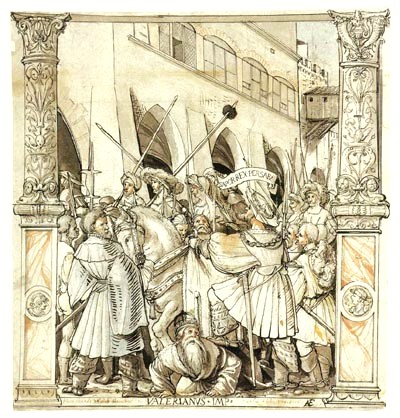A Journey Through History
Following Valeriani
At the beginning of 260, Valerianus was decisively defeated in the Battle of Edessa and
he arranged a meeting with Shapur to negotiate a peace settlement. The truce was betrayed by Shapur who
seized him and held him prisoner for the remainder of his life. Valerianus's capture was a humiliating defeat
for the Romans. Gibbon, in The History of the Decline and Fall of the Roman Empire describes Valerianus's
fate.
The voice of history, which is often little more than the organ of hatred or flattery, reproaches Sapor with a
proud abuse of the rights of conquest. We are told that Valerianus, in chains, but invested with the Imperial
purple, was exposed to the crowd, a constant spectacle of fallen greatness; and that whenever the Persian monarch
mounted on horseback, he placed his foot on the neck of a Roman emperor. Despite all the remonstrances of his
allies, who repeatedly advised him to remember the vicissitudes of fortune, to dread the returning power of Rome,
and to make his illustrious captive the pledge of peace instead of the object of insult, Sapor still remained
inflexible.
When Valerianus sunk under the weight of shame and grief, his skin, stuffed with straw, and formed into the
likeness of a human figure, was preserved for ages in the most celebrated temple of Persia; a more real monument of
triumph, than the fancied trophies of brass and marble so often erected by Roman vanity. The tale is moral and
pathetic, but the truth of it may very fairly be called in question.
The letters still extant from the princes of the East to Sapor are manifest forgeries; nor is it natural to suppose
that a jealous monarch should, even in the person of a rival, thus publicly degrade the majesty of kings. Whatever
treatment the unfortunate Valerianus might experience in Persia, it is at least certain that the only emperor of
Rome who had ever fallen into the hands of the enemy, languished away his life in hopeless captivity.

The Humiliation of Emperor Valerian by Shapur I, pen and ink, Hans
Holbein the Younger, ca. 1521
An early Christian source, Lactantius, maintained that for some time prior to his death
Valerianus was subjected to the greatest insults by his captors, such as being used as a human footstool by
Shapur when mounting his horse. According to this version of events, after a long period of such treatment
Valerianus offered Shapur a huge ransom for his release. In reply, according to one version, Shapur was said
to have forced Valerianus to swallow molten gold (the other version of his death is almost the same but it
says that Valerianus was killed by being flayed alive) and then had the unfortunate Valerianus skinned and
his skin stuffed with straw and preserved as a trophy in the main Persian temple.
It was further alleged by Lactantius that it was only after a later Persian defeat against Rome that his skin was
given a cremation and burial. The role of a prince held hostage by Shapur I, in the events following the death of
Valerianus has been frequently debated by historians, without reaching any definitive conclusion.
Some modern scholars believe that, contrary to Lactantius' account, Shapur the I sent Valerianus and some of his
army to the city of Bishapur or Gundishapur where they lived in relatively good condition. Shapur used the
remaining soldiers in engineering and development plans. Band-e Kaisar (Caesar's dam) is one of the remnants of
Roman engineering located near the ancient city of Susa. In all the stone carvings on Naghshe-Rostam, in Iran,
Valerianus is respected by holding hands with Shapur the I, in sign of submission.
It is generally supposed that some of Lactantius' account is motivated by his desire to establish that persecutors
of the Christians died fitting deaths; the story was repeated then and later by authors in the Roman Near East
"fiercely hostile" to Persia.
Other modern scholars tend to give at least some credence to Lactantius' account. Valerianus and Gallienus' joint
rule was threatened several times by usurpers. Despite several usurpation attempts, Gallienus secured the throne
until his own assassination in 268. Owing to imperfect and often contradictory sources, the chronology and details
of this reign are very uncertain.
| 